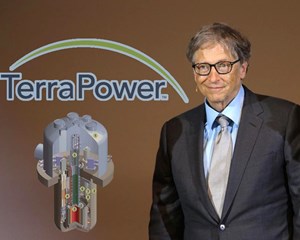Nuclear power
核能
Atoms for greenery
绿色原子
Bill Gates's latest venture is a new-style nuclear reactor
比尔·盖茨的最新投资是一种新型核反应堆
Since handing over the reins as Microsoft's chief executive in 2000, Bill Gates has been best-known for his philanthropy. The Bill and Melinda Gates Foundation, one of the world's largest charities, has given billions of dollars to vaccination drives, family-planning clinics, research into drug treatments for malaria and more.
自从2000年作为微软首席执行官移交权力以来,比尔·盖茨一直以他的慈善事业而闻名。世界上最大的慈善机构之一比尔和梅琳达·盖茨基金会已经向疫苗接种运动、计划生育诊所、疟疾药物治疗研究等领域捐赠了数十亿美元。
But Mr Gates has not abandoned the business world entirely. On June 2nd TerraPower, a company he founded in 2008, announced that it would build a demonstration of an exotic, high-tech nuclear power station in Wyoming. The firm's Natrium reactor is one of a gaggle of new designs that have emerged in recent years, as engineers try to come up with cheaper, simpler nuclear power plants that can provide low carbon electricity with fewer of the cost and safety worries that have plagued the industry in the past.
但是盖茨先生并没有完全放弃商业世界。6月2日,他于2008年创立的泰拉能源公司宣布将在怀俄明州建造一座具有异国风格的高科技核电站。该公司的钠反应堆是近年来涌现的众多新设计之一,工程师们想要设计出更便宜、更简单的核电站,以更低的成本和更少的安全担忧提供低碳电力,过去这些问题一直困扰着核电行业。

The Natrium reactor makes two big changes to the standard nuclear-power-plant design. It replaces the liquid water that normally courses through the core with hot, liquid sodium (natrium, in Latin). And instead of using the heat generated by the reactor to make electricity directly, it first employs it to heat a tank of molten salt that acts as a giant battery. The upshot, the firm hopes, will be a cheaper reactor that is better suited to power grids that will increasingly be dominated by intermittent sources of energy such as wind turbines and solar panels.
钠反应堆对标准核电站的设计做出了两项重大改变。它用炙热的液态钠(拉丁文是:natrium)取代了通常流经核心的液态水。它并没有直接利用反应堆产生的热量发电,而是首先用它加热一个装有熔盐的水箱,这个水箱就像一个巨大的电池。该公司希望,其结果将是一种更便宜的反应堆,更适合电网,而电网将越来越多地由断断续续的能源(如风力涡轮机和太阳能电池板)主导。
Start with the reactor itself. Most nuclear power plants are light-water reactors (LWRS), a technology developed in America in the 1950s. They use ordinary water both to cool the reactor core and to increase the intensity of the chain-reaction by moderating the speed of the neutrons that are emitted when uranium atoms split. Thus slowed, these neutrons are more likely to go on to split more atoms in turn.
从反应堆本身开始。大多数核电站都是轻水反应堆(LWRS),即20世纪50年代在美国发展起来的一种技术。他们使用普通的水来冷却反应堆核心,并通过减慢铀原子分裂时释放的中子的速度来增加链式反应的强度。这样,这些中子就更有可能依次分裂更多的原子。
译文由可可原创,仅供学习交流使用,未经许可请勿转载。











